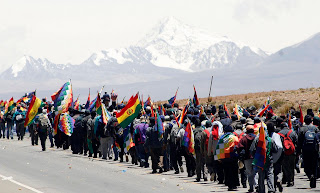Evo Morales’s sweeping victory in the 6 December 2009 general elections is a clear indication that the Bolivian MAS party (Movimiento al Socialismo) has emerged strengthened from its first period of government, having passed key constitutional, economic and social reforms in the face of often undemocratic challenges by a determined opposition.
As well as winning over 64%of the vote for president, the MAS also won a majority in both houses of Congress (now called the Plurinational Legislative Assembly). This will greatly help passage of the large number of laws required to implement the new Bolivian constitution, approved by referendum in January 2009. The MAS benches in both houses now include more social movement leaders, such as Isaac Avalos - executive secretary of the powerful peasant union, the CSUTCB, as well as middle-class professionals such as Ana Maria Romero, a journalist who was Bolivia’s first human rights ombudsman.
While the MAS has shown great strength and unity at the ballot boxes, the opposition was divided and lacked credible leadership. Of two main opposition fronts, the most successful was Plan Progreso para Bolivia (PPB) headed by Manfred Reyes Villa.
Reyes Villa, a former captain in the Bolivian army who had close ties to the highly repressive Garcia Meza dictatorship of the early 1980s, had already suffered electoral defeat in the national recall referendum in August 2008 when he was removed from his post as prefect of Cochabamba. His running mate, former Pando governor Leopoldo Fernandez, an associate of former dictator Hugo Banzer, also had a history of close involvement with Bolivia’s authoritarian-right. He campaigned from his jail cell where he awaits trial for his alleged role in the 2008 Pando massacre of indigenous peasants. They managed a showing of just 26.6% of the national vote.
As well as receiving the firm backing of its support base in the western Andean region, the MAS also made important inroads in the eastern lowlands, the focus of opposition activity during the government’s first term. The MAS vote in the department of Santa Cruz increased from 33% in 2005 to nearly 41% this time round, and the MAS came first in the gas-rich department of Tarija. Voting percentages for the MAS in the other two eastern departments of Pando and Beni more than doubled from their 2005 totals.
An element that contributed to this increase in support in the country’s eastern departments was the inclusion of departmental autonomy in the new constitution, an issue that the opposition had used to rally local support against the government. As well as paving the way for greater decentralisation of power and resources through departmental autonomy the constitution also includes autonomy for indigenous areas, allowing indigenous communities to control the territory where they live and benefit from the resources on it. Among the congress members elected, there were seven – nearly all MAS candidates – who will represent special indigenous constituencies. Special autonomy was also approved by referendum for the gas-rich province of the Gran Chaco in the department of Tarija, in the extreme south-east, an area peopled largely by Guaraní indians.
Alex Tilley, Coordinator of the Bolivia Information Forum



No comments:
Post a Comment